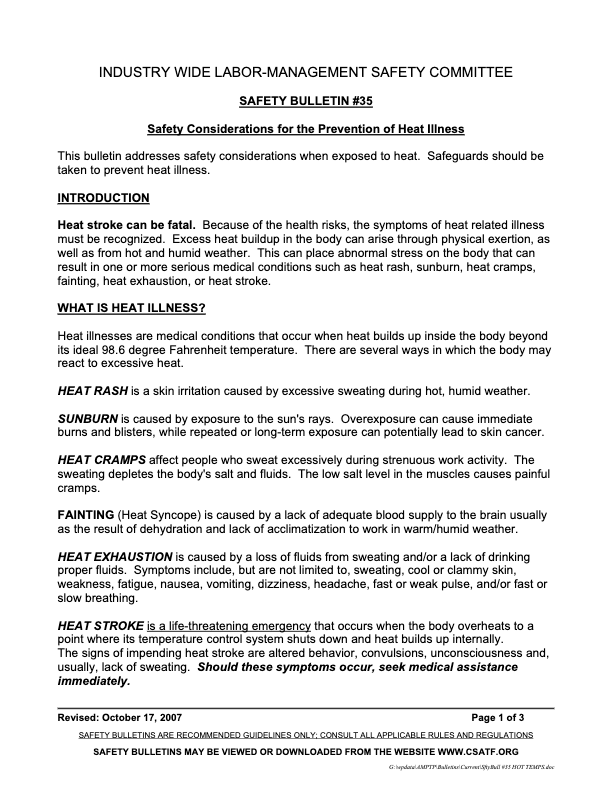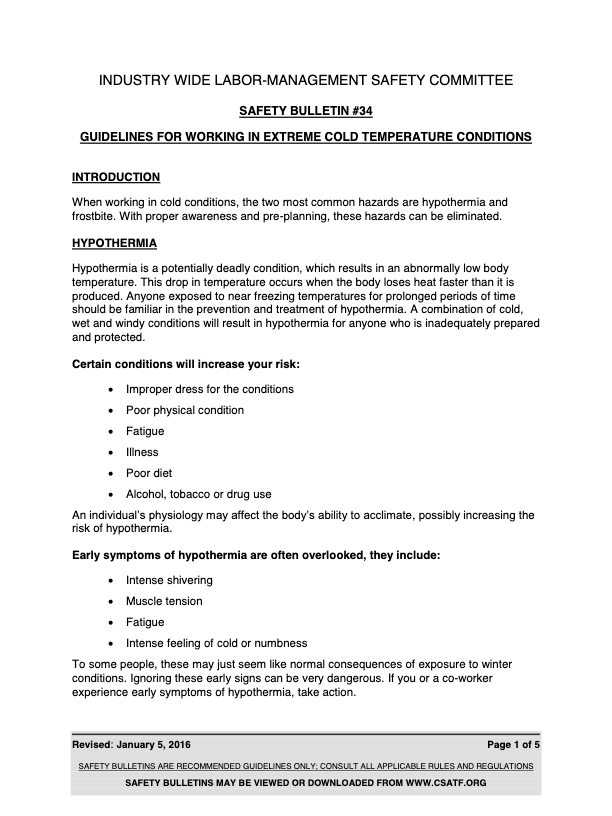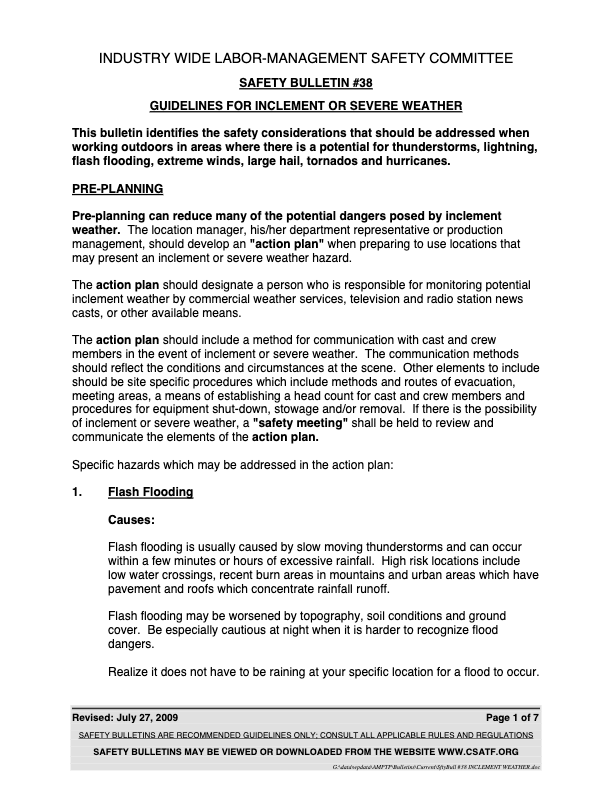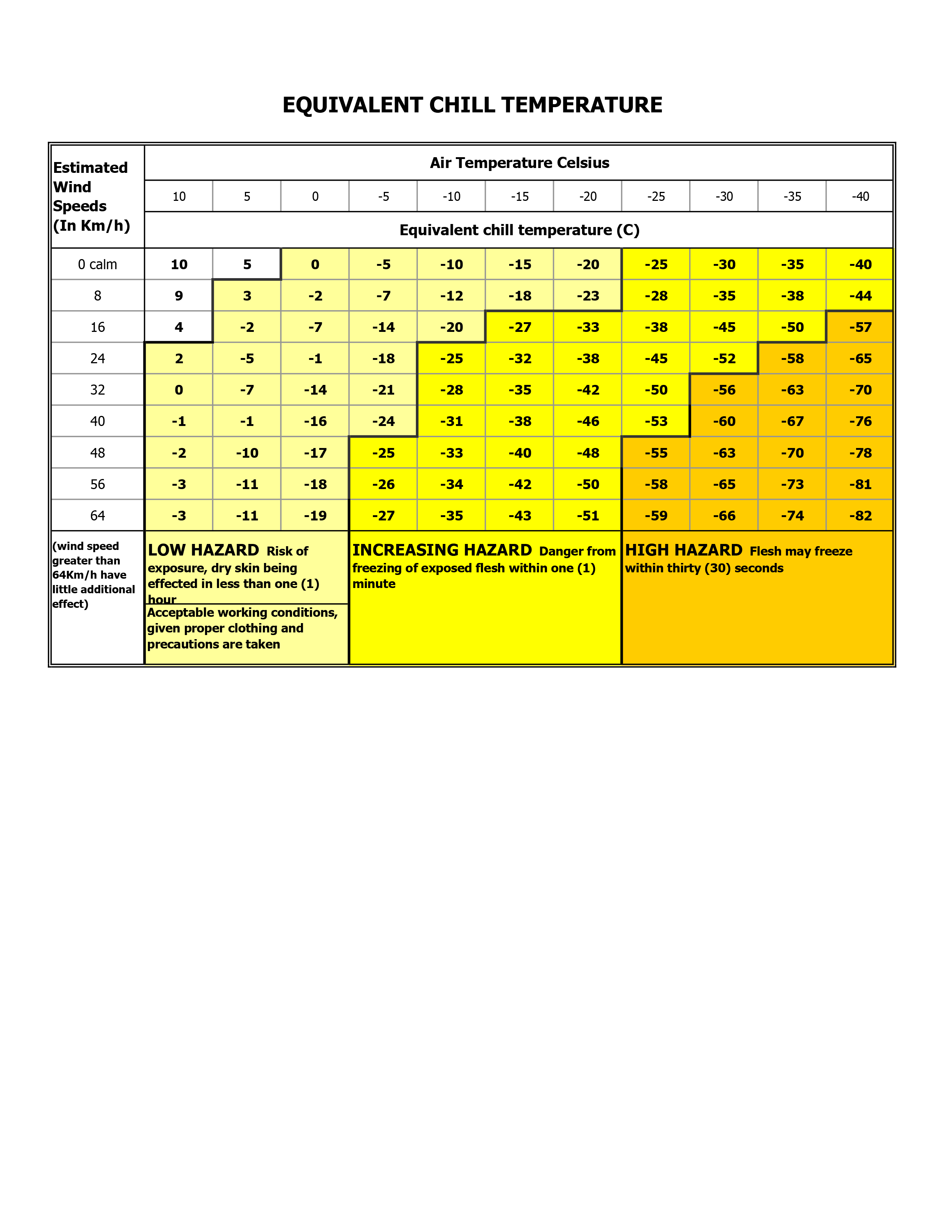Safety Bulletin

Guidelines
This bulletin addresses safety considerations when exposed to heat. Safeguards should be taken to prevent heat illness.
Heat stroke can be fatal. Because of the health risks, the symptoms of heat related illness must be recognized. Excess heat buildup in the body can arise through physical exertion, as well as from hot and humid weather. This can place abnormal stress on the body that can result in one or more serious medical conditions such as heat rash, sunburn, heat cramps, fainting, heat exhaustion, or heat stroke.
What is Heat Illness?
Heat illnesses are medical conditions that occur when heat builds up inside the body beyond its ideal 98.6 degree Fahrenheit temperature. There are several ways in which the body may react to excessive heat.
- HEAT RASH is a skin irritation caused by excessive sweating during hot, humid weather.
- SUNBURN is caused by exposure to the sun’s rays. Overexposure can cause immediate burns and blisters, while repeated or long-term exposure can potentially lead to skin cancer.
- HEAT CRAMPS affect people who sweat excessively during strenuous work activity. The sweating depletes the body’s salt and fluids. The low salt level in the muscles causes painful cramps.
- FAINTING (Heat Syncope) is caused by a lack of adequate blood supply to the brain usually as the result of dehydration and lack of acclimatization to work in warm/humid weather.
- HEAT EXHAUSTION is caused by a loss of fluids from sweating and/or a lack of drinking proper fluids. Symptoms include, but are not limited to, sweating, cool or clammy skin, weakness, fatigue, nausea, vomiting, dizziness, headache, fast or weak pulse, and/or fast or slow breathing.
- HEAT STROKE is a life-threatening emergency that occurs when the body overheats to a point where its temperature control system shuts down and heat builds up internally.
The signs of impending heat stroke are altered behavior, convulsions, unconsciousness and, usually, lack of sweating. Should these symptoms occur, seek medical assistance immediately.
Symptoms of Heat Illness
Early heat illness signs and symptoms may not always follow a progressive pattern from a mild condition such as heat rash up to the life-threatening condition of heat stroke. Thirst alone is a poor indicator of how the body is reacting to heat. Know the symptoms of heat illness to watch for:
- Discomfort
- Headache
- Fatigue
- Loss of coordination
- Vomiting
- Seizures
- Fainting
- Blurry vision
- Confusion
- Dizziness
- Irritability
- Poor concentration
- Muscle pain/cramps
- Lack of sweating or excessive sweating
- Altered behavior
Tell a supervisor immediately if you think you or a co-worker are feeling ill from the heat.
Heat Illness Susceptibility Factors
There are many risk factors that increase susceptibility to heat illness. They include, but are not limited to:
- Environmental Conditions:
- Hot air temperature
- High relative humidity
- Physical activity
- Radiant heat from the sun or other source
- Personal protective equipment worn
- Lack of air movement
- Personal Conditions:
- A history of heat illness
- Insufficient water consumption
- Over/under weight
- Poor level of fitness
- Lack of acclimatization
- Poor medical condition
- Use of prescription and over the counter medications and other drugs
- Consumption of alcohol, caffeine, carbonated drinks, energy drinks
- Advanced age or young age
- On a low salt diet
Consult with a doctor if you know you have risk factors for heat illness.
Acclimatization
During the first few days of working in heat, the body needs time to adjust. This period of adjustment (acclimatization) varies by individual and can take up to a few weeks. During this acclimatization period you should:
- Start work slowly and increase the pace gradually. During a heat wave there is still a risk for heat illness even if previously acclimatized.
- Report to a supervisor if returning to work after an absence or illness, or when changing from a cool to a hot and/or humid climate.
- Supervisors and employees should be aware that acclimatization to heat can take several days and work/rest cycles should be scheduled accordingly.
Heat Illness Prevention
Drink plenty of water
Dehydration occurs quickly no matter how well acclimatized to the heat. The average person loses between 1 and 2 quarts of fluid an hour in perspiration during heavy exertion in hot weather. The only way to replace the loss (and help the body continue to cool itself) is to drink water.
- Frequently drink small quantities of water throughout the entire work shift. A minimum of 1 quart (four 8-oz cups) per hour is recommended.
- Don’t wait until thirsty to drink water. Being thirsty is not a good signal for the need to hydrate. Drink water both before and after work. Avoid substituting soft drinks and coffee for water.
- Drinking water needs to be available for all employees at all work locations.
- Know the location(s) of the closest drinking water supplies.
Wear Appropriate Work Clothes and Cool Down Under Cover
- Know the nearest cool resting place(s). Get out of the sun or away from the source of heat and find a cool, preferably well ventilated, resting place when you are starting to overheat or need to cool down.
- Wear light-colored loose fitting long-sleeved shirt and pants, and UV sunglasses or, if appropriate, other protective equipment.
- Wear a wide brim hat (baseball caps do not cover the ears and neck).
- Use sunscreen or sun block and reapply as needed.
- Eat light meals. Hot, heavy meals add heat to the body.
Summary
Heat illness is preventable. Know your limits and take time to adjust to the heat. Above all, drink plenty of water and immediately report any signs of heat illness in yourself or others.



